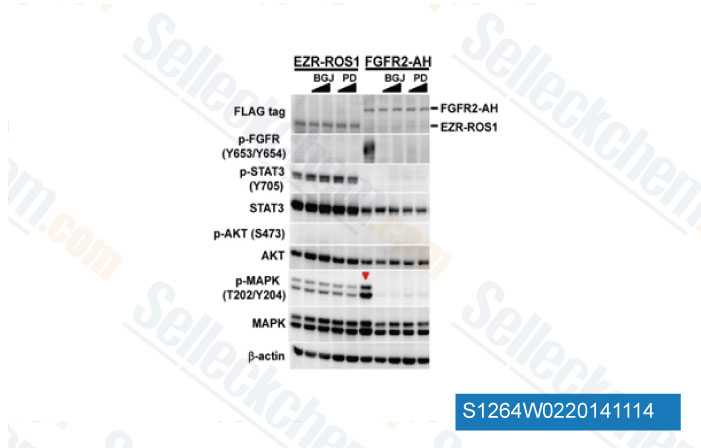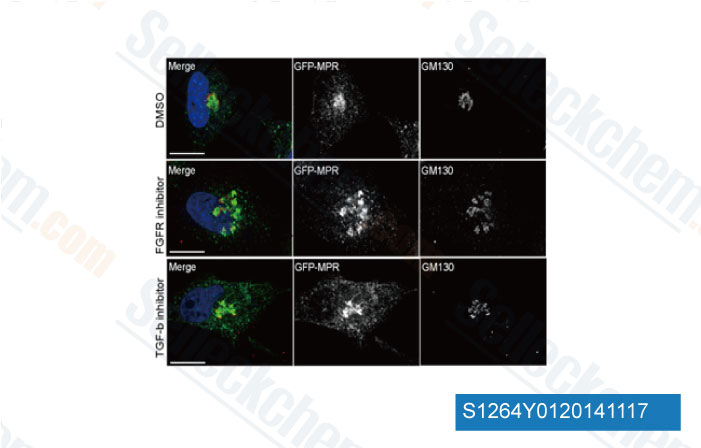|
How to Cite 1. For In-Text Citation (Materials & Methods): 2. For Key Resources Table: |
||
|
Toll Free: (877) 796-6397 -- USA and Canada only -- |
Fax: +1-832-582-8590 Orders: +1-832-582-8158 |
Tech Support: +1-832-582-8158 Ext:3 Please provide your Order Number in the email. We strive to reply to |
Technical Data
| Formula | C28H41N7O3 |
||||||||||
| Molecular Weight | 523.67 | CAS No. | 219580-11-7 | ||||||||
| Solubility (25°C)* | In vitro | DMSO | 100 mg/mL (190.95 mM) | ||||||||
| Ethanol | 50 mg/mL (95.47 mM) | ||||||||||
| Water | Insoluble | ||||||||||
| In vivo (Add solvents to the product individually and in order) |
|
||||||||||
|
* <1 mg/ml means slightly soluble or insoluble. * Please note that Selleck tests the solubility of all compounds in-house, and the actual solubility may differ slightly from published values. This is normal and is due to slight batch-to-batch variations. * Room temperature shipping (Stability testing shows this product can be shipped without any cooling measures.) |
|||||||||||
Preparing Stock Solutions
Biological Activity
| Description | PD173074 is a potent FGFR1 inhibitor with IC50 of ~25 nM and also inhibits VEGFR2 with IC50 of 100-200 nM in cell-free assays, ~1000-fold selective for FGFR1 than PDGFR and c-Src. PD173074 reduces proliferation and promotes apoptosis in gastric cancer cells. | ||||
|---|---|---|---|---|---|
| Targets |
|
||||
| In vitro | PD173074 is an ATP-competitive inhibitor of FGFR1 with Ki of ~40 nM. This compound is also an effective inhibitor of VEGFR2. Compared to FGFR1, it weakly inhibits the activities of Src, InsR, EGFR, PDGFR, MEK, and PKC with 1000-fold or greater IC50 values. This inhibitor inhibits autophosphorylation of FGFR1 and VEGFR2 in a dose-dependent manner with IC50 of 1-5 nM and 100-200 nM, respectively. [1] It inhibits FGF-2 promotion of granule neuron survival in a dose-dependent manner with IC50 of 12 nM, exhibiting 1,000-fold greater potency than that of SU 5402. [2] This chemical specifically inhibits FGF-2-mediated effects on proliferation, differentiation, and MAPK activation in oligodendrocyte (OL) lineage cells. [3] It is active against the WT receptor and FGFR3 mutations in multiple myeloma (MM) cell lines. This compound also potently inhibits autophosphorylation of FGFR3 in a dose-dependent manner with IC50 of ~5 nM. Its treatment potently reduces viability of FGFR3-expressing KMS11 and KMS18 cells with IC50 of <20 nM. Inhibition of aFGF-stimulated MM cell growth by this agent is highly correlated with the expression of FGFR3. Its treatment completely abolishes NIH 3T3 transformation mediated by Y373C FGFR3 but not by Ras V12, demonstrating that it specifically targets FGFR3-mediated cell transformation and lacks nonspecific cytotoxic effect. This chemical also induces functional maturation of KMS11 and KMS18 cells. [4] | ||||
| In vivo | Administration of PD173074 at 1 mg/kg/day or 2 mg/ka/day in mice can effectively block angiogenesis induced by either FGF or VEGF in a dose-dependent manner with no apparent toxicity. [1] This compound inhibits in vivo growth of mutant FGFR3-transfected NIH 3T3 cells in nude mice. Inhibition of FGFR3 by this chemical delays tumor growth and increases survival of mice in a KMS11 xenograft myeloma model. [4] In the H-510 xenograft, oral aministration of this compound blocks tumor growth similar to that seen with single-agent cisplatin administration, increasing median survival compared with control sham-treated animals. In H-69 xenografts, this chemical induces complete responses lasting >6 months in 50% of mice. These effects are correlated with increased apoptosis in excised tumors, but not a consequence of disrupted tumor vasculature. [5] |
Protocol (from reference)
| Kinase Assay:[1] |
|
|---|---|
| Cell Assay:[4] |
|
| Animal Study:[1] |
|
References
|
Customer Product Validation

-
Data from [ Hepatology , 2014 , 59(4) ,1427-34 ]

-
Data from [ J Cell Sci , 2014 , 10.1242/jcs.159608 ]

-
Data from [ Cancer Discov , 2013 , 3(6), 636-47 ]

-
Data from [ PLoS Genet , 2012 , 8(2), e1002500 ]
Selleck's PD173074 Has Been Cited by 129 Publications
| Signaling pathway-based culture condition improves differentiation potential of canine induced pluripotent stem cells [ Stem Cell Reports, 2025, 20(10):102640] | PubMed: 40972586 |
| NLRP7 maintains the genomic stability during early human embryogenesis via mediating alternative splicing [ Commun Biol, 2025, 8(1):125] | PubMed: 39865169 |
| Modeling the atrioventricular conduction axis using human pluripotent stem cell-derived cardiac assembloids [ Cell Stem Cell, 2024, S1934-5909(24)00294-7] | PubMed: 39260368 |
| Chimerization of human ESC-derived extraembryonic cells with the mouse blastocyst [ Int J Biol Sci, 2024, 20(13):5056-5069] | PubMed: 39430245 |
| FGF receptors mediate cellular senescence in the cystic fibrosis airway epithelium [ JCI Insight, 2024, 9(15)e174888] | PubMed: 38916962 |
| PP2 suppresses proliferation and migration of C6 Glioma and MDA-MB-231 cells by targeting both fibroblast growth factor receptor 1 and Src [ Chem Biol Interact, 2024, 403:111252] | PubMed: 39341487 |
| Smad4 is essential for epiblast scaling and morphogenesis after implantation, but nonessential before implantation [ Development, 2024, 151(11)dev202377] | PubMed: 38752427 |
| Smad4 is essential for epiblast scaling and morphogenesis after implantation, but nonessential prior to implantation in the mouse [ bioRxiv, 2024, 2024.01.23.576717] | PubMed: 38328075 |
| FGF21 increases the sensitivity of sorafenib to hepatocellular carcinoma under hypoxia [ Malignancy Spectrum, 2024, 10.1002/msp2.20] | PubMed: none |
| Dietary phosphorus consumption alters T cell populations, cytokine production, and bone volume in mice [ JCI Insight, 2023, 8(10)e154729] | PubMed: 37079375 |
RETURN POLICY
Selleck Chemical’s Unconditional Return Policy ensures a smooth online shopping experience for our customers. If you are in any way unsatisfied with your purchase, you may return any item(s) within 7 days of receiving it. In the event of product quality issues, either protocol related or product related problems, you may return any item(s) within 365 days from the original purchase date. Please follow the instructions below when returning products.
SHIPPING AND STORAGE
Selleck products are transported at room temperature. If you receive the product at room temperature, please rest assured, the Selleck Quality Inspection Department has conducted experiments to verify that the normal temperature placement of one month will not affect the biological activity of powder products. After collecting, please store the product according to the requirements described in the datasheet. Most Selleck products are stable under the recommended conditions.
NOT FOR HUMAN, VETERINARY DIAGNOSTIC OR THERAPEUTIC USE.
